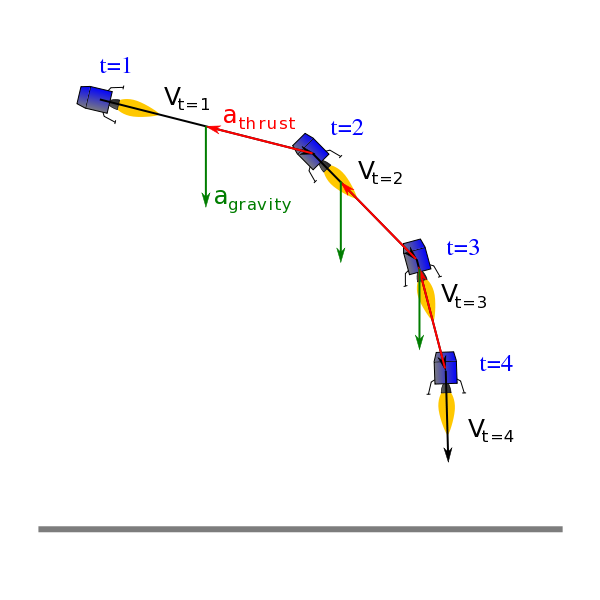Difference between revisions of "Gravity turn/ja"
Kspjptrans (talk | contribs) (Created page with "'''gravity turn'''(重力ターン) is a maneuver used to launch a craft into, or descend from, orbit around a celestial body while using minimal fuel. In order t...") |
Rocketdocker (talk | contribs) m (Edits.) |
||
| (10 intermediate revisions by 3 users not shown) | |||
| Line 1: | Line 1: | ||
| − | ''' | + | '''重力ターン'''とは、最少の燃料消費で[[celestial body|天体]]の[[orbit|周回軌道]]に[[craft|機体]]を投入する、あるいは周回軌道から降下させるマニューバである。機体が地表から上昇するには、重力より大きな垂直方向の加速度が必要である。また、安定軌道に乗るには、地表の障害物を避け、[[atmosphere|大気]]があれば空気抵抗のない高い高度において充分な水平方向の速度を得る必要がある。重力ターンは、この2つのステップを1つのマニューバで行うことで消費燃料を抑える。機体をまず垂直に上昇させ、しだいに水平方向に傾けていき、最終的に完全に水平にする。 |
| − | + | 例えば、重力ターンを一切せずに周回軌道に乗せる場合、垂直に上昇し、充分な高度になったら90°回頭して水平方向に加速することになる。重力ターンは、この直角ターンに対して、手前を曲がる「ショートカット」のようなものだ。つまり近道をして燃料を節約する。 | |
| − | + | この方法は周回軌道から着陸する場合にも使える。水平方向の速度を無くしてから垂直にゆっくり降下するより、斜め方向に噴射して水平垂直両方向を同時に相殺したほうが効率が良い。 | |
| − | == | + | == メカニズム == |
| − | + | <div style="float:right;"> | |
| − | + | <gallery> | |
| − | + | Gravity turn start.svg|離陸時の合力 | |
| + | Gravity turn executed.svg|機体を30°傾けた状態の合力 | ||
| + | </gallery> | ||
| + | </div> | ||
| − | + | 重力ターンでは、必要最小限の力で重力に抵抗しながら任意の軌道に必要な高度と速度を得る。重力は常に機体を引っ張るので、天体から離れる方向へは常時遅く加速し、それ以外の方向へ速く加速すればよい。発射した機体が完全に垂直方向にのみ上昇していった場合、その機体は最も遅くて良い方向への加速に全推力を傾け、ほとんどの[[Delta-V|デルタV]]を消費したことになり、軌道投入に必要な水平方向のスピードを得ずに、最低のスピードを得ることになる。言い換えれば、垂直打ち上げは最も効率の悪い打ち上げである。 | |
| − | + | 重力ターンのマニューバは次の手順で行う。発射場所を完全に平らと想定し、まず'''垂直上昇'''を行なう。一定の高度に達したら、'''ピッチオーバー'''と呼ばれるわずかなターンを行なう。垂直から若干傾くと、機体の速度ベクトルは重力に下向きに引っ張られ、機体もそれに従うように傾いていく。これが起こると機体は重力に直接逆らう方向以外のベクトルに進むのでより速いスピードをより早く得られ、時間と燃料を節約できる。ベクトルがさらに横方向へ傾くにつれ、推力のうち重力抵抗に消費される割合は減少し、スピード獲得に消費される割合は増加する。このベクトル変化のほとんどは操縦ではなく重力によって行われるので、ここでも僅かに燃料が節約される。重力ターン中、燃料は重力に逆らうことに無駄に消費されない。機体が山や大気より高い高度で充分な水平方向へのスピードを得たら、安定した軌道に入る。 | |
| − | + | ピッチオーバーによって重力ターンを始める高度は、いくつかの要素で決定される。[[atmosphere|大気]]のある天体では、大気圧と空気抵抗が効率的な重力ターンを決定する。 | |
| − | + | == タイミング == | |
| − | # | + | [[File:Gravity turn trajectory.png|thumb|320px|カービンから高度70kmに到達するまでの軌道]] |
| − | # | + | 重力ターンをいつ始めるか、どのくらい傾けるかは主に3つの要素に基づく: |
| − | # | + | # 飛行経路上のあらゆる障害物 |
| + | # 大気の密度、[[drag|空気抵抗]]、最大推力 | ||
| + | # 天体の重力と機体の[[thrust-to-weight ratio|推力重量比(TWR)]]の兼ね合い | ||
| − | + | 丘や山などに差し掛かる経路を避けるべきなのは明らかだ。障害物を避けるように経路を設定することで効率は下がるかもしれないが、墜落するよりはマシだ。 | |
| − | + | 大気のない天体では空気抵抗を心配する必要がないので、TWRと地表高度が許す範囲で、出来るだけ早く水平に近づければ良い。これによって重力への抵抗に消費する推力の割合を最小化し、周回軌道に必要な水平方向のスピードを得るのに消費する推力の割合を最大化する。 | |
| − | + | 一方、大気のある天体では、開始高度と傾斜量は、重力ターンの成功・効率性に重大な影響を及ぼす。ターン開始が遅すぎたり、角度が浅すぎると、空気抵抗への燃料消費は少ないが、重力抵抗に無駄に消費する燃料が増える。ターン開始が早すぎたり角度が深すぎると、大気中を通過する距離が長くなり、空気抵抗で多くのスピードを失い、それを補うのに多くの燃料を消費する。また、そのようなターンで大気圏を抜けるより早く機体が水平を向いてしまった場合、そのときのステージのTWRが充分なら、さらにデルタVを消費して高度を得る必要がある。もしTWRが充分でないなら墜落不可避。上段はTWRが低い場合が多いため、上段が十分な高度に到達できない状況を避けるために、より高い高度や浅い角度でターンすることは一般に安全である。密度の高い大気を上昇する場合は、高すぎる速度は機体を損傷させる可能性があり、重力を逃れるよりも空気抵抗に消費される燃料を増加させるため、[[atmosphere#Terminal velocity|終端速度]]は最適な上昇速度を示す重要な要素となる。 | |
| − | + | 天体の重力の強さも影響する。非常に強い重力をもつ天体では、推力のうち多くの割合を重力抵抗に使わなければならず、高度と水平スピードを得るのに使用できる割合は少ない。そのような天体では、高高度・低角度で行えば良い。反対に、重力の非常に弱い天体では、低高度・高角度で行う。機体のTWRもターン開始タイミングに影響する。TWRが非常に高ければ推力に余裕が生まれるので、重力抵抗に使う割合を抑え、その分をスピード獲得に振り分けられる。つまりTWRの高い機体は、そうでない機体より、重力ターンを低く鋭角にでき、より低いΔV消費によって、より速く、より効率的に上昇できる。 | |
| − | + | 重力ターンはいつでも完璧にできるわけではない。重力ターンはその後の円軌道化まで連続的に燃焼がおこなわれるとき最も効率的となるが、[[Thrust-to-weight ratio#Physical background|飛行にともなうTWRの変化]]や、人間の反応速度などの要素もあって完璧から遠ざかってしまう。そのような場合、大気を抜けたら一旦燃焼を停止し、Aa(遠点高度)に近づいたら円軌道化の燃焼をすればよいだろう。 | |
| − | + | 適切なタイミングと角度について例を挙げると、[[Kerbin/ja|カービン]]の場合、垂直上昇後、速度150m/s(または高度2km)で東に約5度傾け、順行マーカーの傾きに機首を合わせていく。大気圏を抜ける前にApが近づくときは、順行マーカーよりやや上に機首をあわせるようにすると良い。機体(および天体)毎の効率的な傾斜とスピードを知るには実験を重ねる必要がある。理想的な軌道は高度とともに徐々に順行マーカー({{mark|prog}})が傾いていく。 | |
| − | == Thrust-to- | + | == 推力重量比 == |
| + | [[Thrust-to-weight ratio|推力重量比(TWR)]]は重力ターンに大きく影響する要素である。燃料を消費することで機体のTWRは次第に上がっていく。またTWRはステージ移行でタンクを切り離せば上がり、エンジンを切り離せば下がる。鋭角すぎる重力ターンをすると大気を抜ける前にパワフルな下段ステージを使いきってしまう可能性があり、そうなると次の高高度用の低TWRステージでは重力に打ち勝てなくなり墜落する。浅すぎる重力ターンをすると、大気を抜けるまでパワフルな下段ステージをもたせられるだろうが、次のステージが充分なTWRを持っていないと円軌道化が終わる前に再突入し墜落する。 | ||
| − | + | == 着陸 == | |
| + | [[File:Gravity turn - landing phase.svg|left|重力ターンによる着陸]] | ||
| + | 重力ターンは効率的な手順で着陸する鍵を握る。上昇との主な違いは、時間の経過とともに発生するイベントである。[[terminology/ja#retrograde|逆行]]({{nowrap|({{mark|retg}})}})噴射によって、機体は垂直方向への噴射に移行しながら水平方向への速度を失っていき、完全に垂直になって地表に到達する。 | ||
| − | == | + | The presence of the atmosphere gives a great aid as the [[drag]] is always pointing to the opposite direction on the velocity (if not effected by aerodynamic lift or any extra powered assist) - means prograde required for the gravity turn. The drag forces a kind of gravity turn on the vehicle - and the effect can be augmented using [[parachute|chutes]]. The parachutes can decrease the descending speed (= terminal velocity) for safe landing without any power assist in a properly dense atmosphere. |
| + | |||
| + | The situation of same on celestial bodies without atmosphere, just the maneuver has to be accomplished without the aid of always well-orientated "free engine" called drag. The pitchover maneuver must be started immediately after leaving the surface (minimal vertical climbing), and has to accelerate with full power for the most efficient ascending on bodies without atmosphere. It means (as playing it backward) the full-power deceleration (retrogade burn {{nowrap|({{mark|retg}})}}) has to be started as late as possible to be finished turning to vertical just above the surface. The approximating the "ideal" trajectory means increasing efficiency - and danger too. Rationally, some clearance is needed, but the descending speed has to be maximized reasonably after the craft turned to vertical orientation. | ||
| + | |||
| + | == 参照 == | ||
* {{Wikipedia}} | * {{Wikipedia}} | ||
| − | [[Category:Maneuvers]] | + | [[Category:Terminology/ja]] |
| − | [[Category: | + | [[Category:Maneuvers/ja]] |
| + | [[Category:Main topics/ja]] | ||
Latest revision as of 18:27, 18 January 2020
重力ターンとは、最少の燃料消費で天体の周回軌道に機体を投入する、あるいは周回軌道から降下させるマニューバである。機体が地表から上昇するには、重力より大きな垂直方向の加速度が必要である。また、安定軌道に乗るには、地表の障害物を避け、大気があれば空気抵抗のない高い高度において充分な水平方向の速度を得る必要がある。重力ターンは、この2つのステップを1つのマニューバで行うことで消費燃料を抑える。機体をまず垂直に上昇させ、しだいに水平方向に傾けていき、最終的に完全に水平にする。
例えば、重力ターンを一切せずに周回軌道に乗せる場合、垂直に上昇し、充分な高度になったら90°回頭して水平方向に加速することになる。重力ターンは、この直角ターンに対して、手前を曲がる「ショートカット」のようなものだ。つまり近道をして燃料を節約する。
この方法は周回軌道から着陸する場合にも使える。水平方向の速度を無くしてから垂直にゆっくり降下するより、斜め方向に噴射して水平垂直両方向を同時に相殺したほうが効率が良い。
メカニズム
重力ターンでは、必要最小限の力で重力に抵抗しながら任意の軌道に必要な高度と速度を得る。重力は常に機体を引っ張るので、天体から離れる方向へは常時遅く加速し、それ以外の方向へ速く加速すればよい。発射した機体が完全に垂直方向にのみ上昇していった場合、その機体は最も遅くて良い方向への加速に全推力を傾け、ほとんどのデルタVを消費したことになり、軌道投入に必要な水平方向のスピードを得ずに、最低のスピードを得ることになる。言い換えれば、垂直打ち上げは最も効率の悪い打ち上げである。
重力ターンのマニューバは次の手順で行う。発射場所を完全に平らと想定し、まず垂直上昇を行なう。一定の高度に達したら、ピッチオーバーと呼ばれるわずかなターンを行なう。垂直から若干傾くと、機体の速度ベクトルは重力に下向きに引っ張られ、機体もそれに従うように傾いていく。これが起こると機体は重力に直接逆らう方向以外のベクトルに進むのでより速いスピードをより早く得られ、時間と燃料を節約できる。ベクトルがさらに横方向へ傾くにつれ、推力のうち重力抵抗に消費される割合は減少し、スピード獲得に消費される割合は増加する。このベクトル変化のほとんどは操縦ではなく重力によって行われるので、ここでも僅かに燃料が節約される。重力ターン中、燃料は重力に逆らうことに無駄に消費されない。機体が山や大気より高い高度で充分な水平方向へのスピードを得たら、安定した軌道に入る。
ピッチオーバーによって重力ターンを始める高度は、いくつかの要素で決定される。大気のある天体では、大気圧と空気抵抗が効率的な重力ターンを決定する。
タイミング
重力ターンをいつ始めるか、どのくらい傾けるかは主に3つの要素に基づく:
- 飛行経路上のあらゆる障害物
- 大気の密度、空気抵抗、最大推力
- 天体の重力と機体の推力重量比(TWR)の兼ね合い
丘や山などに差し掛かる経路を避けるべきなのは明らかだ。障害物を避けるように経路を設定することで効率は下がるかもしれないが、墜落するよりはマシだ。
大気のない天体では空気抵抗を心配する必要がないので、TWRと地表高度が許す範囲で、出来るだけ早く水平に近づければ良い。これによって重力への抵抗に消費する推力の割合を最小化し、周回軌道に必要な水平方向のスピードを得るのに消費する推力の割合を最大化する。
一方、大気のある天体では、開始高度と傾斜量は、重力ターンの成功・効率性に重大な影響を及ぼす。ターン開始が遅すぎたり、角度が浅すぎると、空気抵抗への燃料消費は少ないが、重力抵抗に無駄に消費する燃料が増える。ターン開始が早すぎたり角度が深すぎると、大気中を通過する距離が長くなり、空気抵抗で多くのスピードを失い、それを補うのに多くの燃料を消費する。また、そのようなターンで大気圏を抜けるより早く機体が水平を向いてしまった場合、そのときのステージのTWRが充分なら、さらにデルタVを消費して高度を得る必要がある。もしTWRが充分でないなら墜落不可避。上段はTWRが低い場合が多いため、上段が十分な高度に到達できない状況を避けるために、より高い高度や浅い角度でターンすることは一般に安全である。密度の高い大気を上昇する場合は、高すぎる速度は機体を損傷させる可能性があり、重力を逃れるよりも空気抵抗に消費される燃料を増加させるため、終端速度は最適な上昇速度を示す重要な要素となる。
天体の重力の強さも影響する。非常に強い重力をもつ天体では、推力のうち多くの割合を重力抵抗に使わなければならず、高度と水平スピードを得るのに使用できる割合は少ない。そのような天体では、高高度・低角度で行えば良い。反対に、重力の非常に弱い天体では、低高度・高角度で行う。機体のTWRもターン開始タイミングに影響する。TWRが非常に高ければ推力に余裕が生まれるので、重力抵抗に使う割合を抑え、その分をスピード獲得に振り分けられる。つまりTWRの高い機体は、そうでない機体より、重力ターンを低く鋭角にでき、より低いΔV消費によって、より速く、より効率的に上昇できる。
重力ターンはいつでも完璧にできるわけではない。重力ターンはその後の円軌道化まで連続的に燃焼がおこなわれるとき最も効率的となるが、飛行にともなうTWRの変化や、人間の反応速度などの要素もあって完璧から遠ざかってしまう。そのような場合、大気を抜けたら一旦燃焼を停止し、Aa(遠点高度)に近づいたら円軌道化の燃焼をすればよいだろう。
適切なタイミングと角度について例を挙げると、カービンの場合、垂直上昇後、速度150m/s(または高度2km)で東に約5度傾け、順行マーカーの傾きに機首を合わせていく。大気圏を抜ける前にApが近づくときは、順行マーカーよりやや上に機首をあわせるようにすると良い。機体(および天体)毎の効率的な傾斜とスピードを知るには実験を重ねる必要がある。理想的な軌道は高度とともに徐々に順行マーカー(![]() )が傾いていく。
)が傾いていく。
推力重量比
推力重量比(TWR)は重力ターンに大きく影響する要素である。燃料を消費することで機体のTWRは次第に上がっていく。またTWRはステージ移行でタンクを切り離せば上がり、エンジンを切り離せば下がる。鋭角すぎる重力ターンをすると大気を抜ける前にパワフルな下段ステージを使いきってしまう可能性があり、そうなると次の高高度用の低TWRステージでは重力に打ち勝てなくなり墜落する。浅すぎる重力ターンをすると、大気を抜けるまでパワフルな下段ステージをもたせられるだろうが、次のステージが充分なTWRを持っていないと円軌道化が終わる前に再突入し墜落する。
着陸
重力ターンは効率的な手順で着陸する鍵を握る。上昇との主な違いは、時間の経過とともに発生するイベントである。逆行((![]() ))噴射によって、機体は垂直方向への噴射に移行しながら水平方向への速度を失っていき、完全に垂直になって地表に到達する。
))噴射によって、機体は垂直方向への噴射に移行しながら水平方向への速度を失っていき、完全に垂直になって地表に到達する。
The presence of the atmosphere gives a great aid as the drag is always pointing to the opposite direction on the velocity (if not effected by aerodynamic lift or any extra powered assist) - means prograde required for the gravity turn. The drag forces a kind of gravity turn on the vehicle - and the effect can be augmented using chutes. The parachutes can decrease the descending speed (= terminal velocity) for safe landing without any power assist in a properly dense atmosphere.
The situation of same on celestial bodies without atmosphere, just the maneuver has to be accomplished without the aid of always well-orientated "free engine" called drag. The pitchover maneuver must be started immediately after leaving the surface (minimal vertical climbing), and has to accelerate with full power for the most efficient ascending on bodies without atmosphere. It means (as playing it backward) the full-power deceleration (retrogade burn (![]() )) has to be started as late as possible to be finished turning to vertical just above the surface. The approximating the "ideal" trajectory means increasing efficiency - and danger too. Rationally, some clearance is needed, but the descending speed has to be maximized reasonably after the craft turned to vertical orientation.
)) has to be started as late as possible to be finished turning to vertical just above the surface. The approximating the "ideal" trajectory means increasing efficiency - and danger too. Rationally, some clearance is needed, but the descending speed has to be maximized reasonably after the craft turned to vertical orientation.
参照
- Gravity turn on Wikipedia



